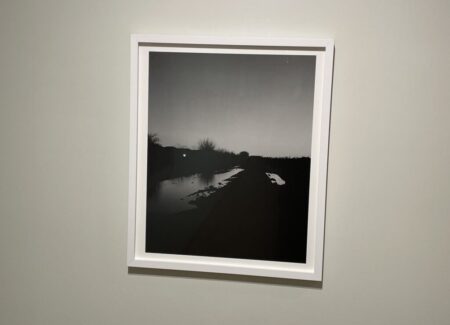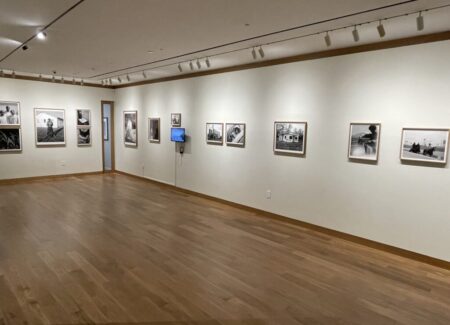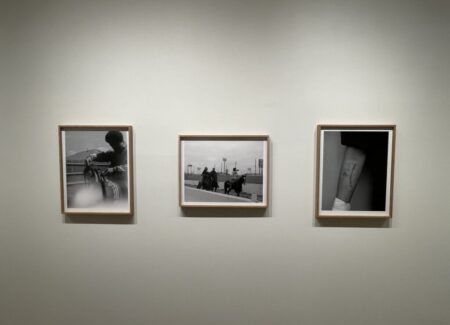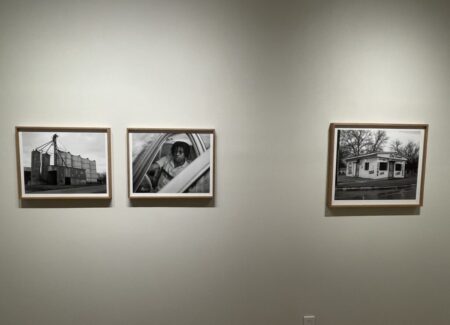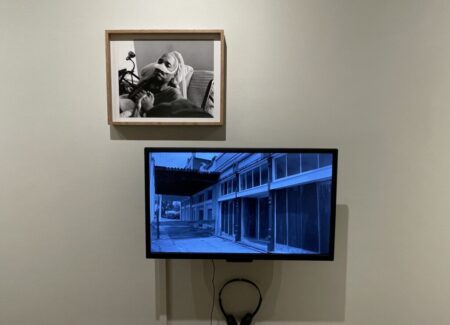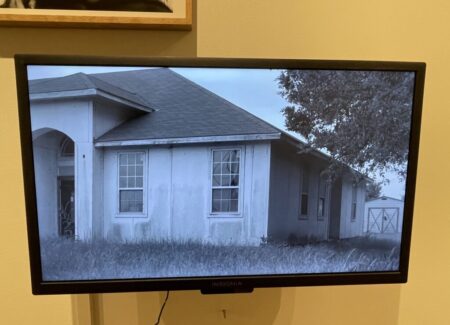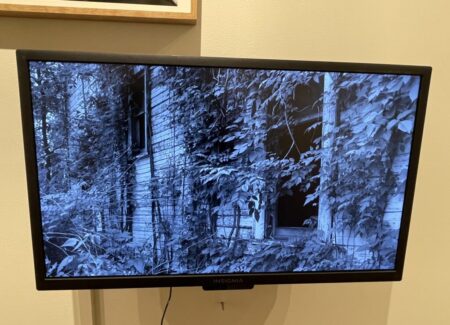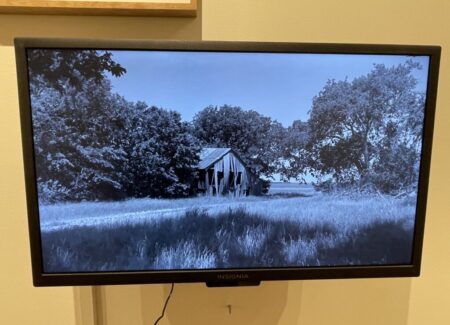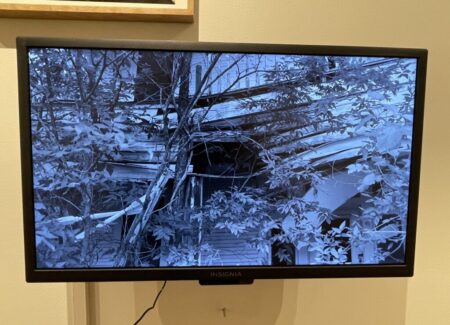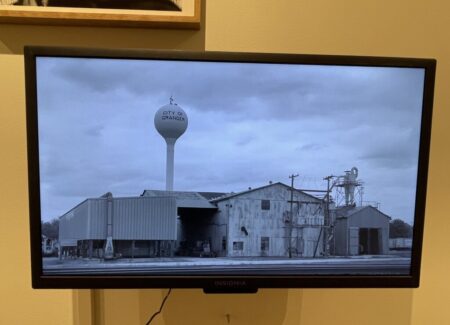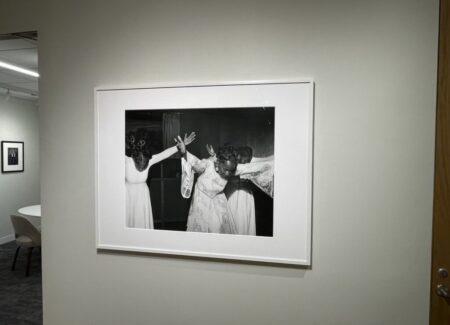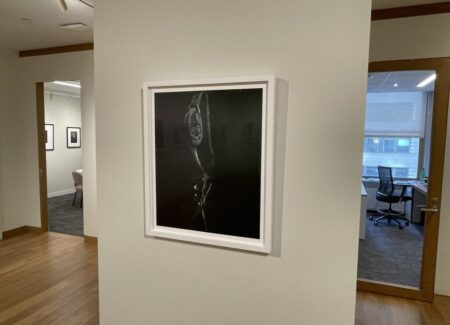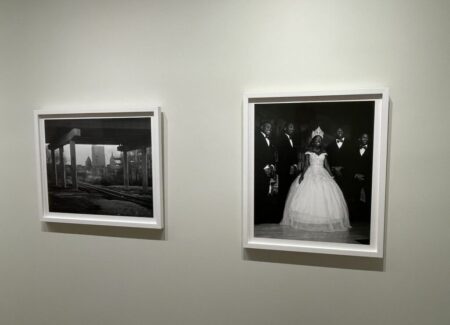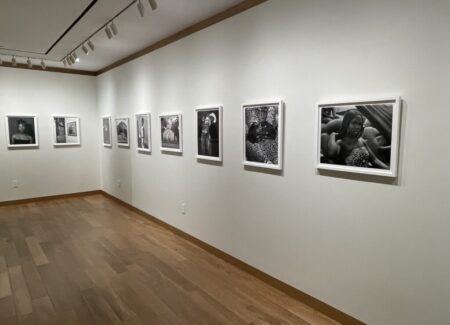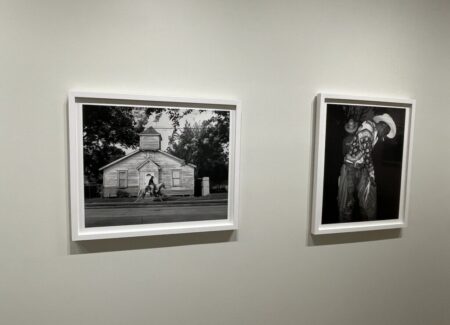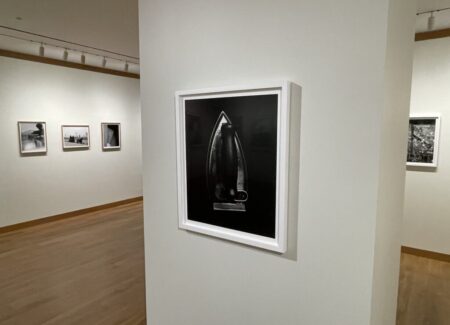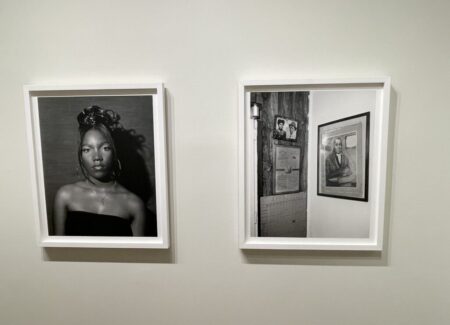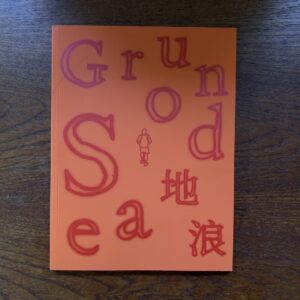JTF (just the facts): A total of 33 black-and-white photographs, alternately framed in light wood and white and unmatted, and hung against cream colored walls in the main gallery space. (Installation shots and video stills below.)
The following works are included in the show:
- 4 gelatin silver prints, 2020, sized 40×30 (or the reverse) inches, in editions of 3+1AP
- 20 gelatin silver prints, 2019, 2020, 2021, 2022, 2023, sized 24×20 (or the reverse) inches, in editions of 7+2AP
- 7 gelatin silver prints, 2019, 2020, 2021, sized 20×16 (or the reverse) inches
- 2 gelatin silver prints, 2019, 2020, sized 11×14 inches
- 1 video (in collaboration with Dé Randle), 2022, 10 minutes 15 seconds
Comments/Context: It’s a simple, and perhaps obvious, observation that context and presentation matter when looking at photography. Seeing a body of work in book form is different than seeing it in a gallery setting – most notably because fine prints are generally richer than even the best reproductions, but also because the scale and spatial dynamics of distance (or intimacy) change, leading to a different kind of engagement and interaction with the work. The same can be said about seeing a full presentation of a single project versus a tight survey of a decade’s work, in that the curatorial edit changes the rhythms of what we’re shown, the trade offs of depth and breadth altering the patterns, resonances, and connections we might notice.
These ideas were swimming around in my head as I visited Rahim Fortune’s current gallery show. In the past few years, we’ve reviewed several of Fortune’s excellent photobooks, starting with his self-published Fantasy in 2020 (reviewed here), and followed up by I can’t stand to see you cry in 2021 (reviewed here), and most recently Hardtack in 2024 (reviewed here). So it might be easy to conclude that we didn’t need to review his gallery show, as its mix of images from his latest two projects covers ground across which we’ve already traveled. But seeing well-crafted prints in person always changes things for me, and the combination edit of this show offers the opportunity to see both continuity and evolution in Fortune’s artistic thinking.
While the show is essentially organized into two halves, on opposing sides of the gallery space, my experience of the installation felt more intermingled, with subjects and approaches recurring around the room. What immediately struck me was just how consistently talented Fortune is as a portraitist, and relatedly, as an observer of nuanced and poignant gesture, of family, friends, and strangers alike. The trajectory of his own father’s illness and death connects several images, first seen in an emotional portrait of his father on a ventilator, and then in an image of boys in white shirts at the wake, and arms delicately interlocked during the first holidays after his passing. Another pair of images features Fortune’s grandmother, in a memorable still life of her hands folded in the lap of her boldly patterned dress, and in a second image where the touch of a relative provides comfort on her shoulder.
This compassionate attentiveness to people and their poses and movements comes through in many other images on view here. There are photographs of couples embracing and the subtle connection of their bodies. There are portraits in cars, where the angles of the windows provide framing interruptions, but the controlled space also offers a sense of personal confidence and ease. And Fortune notices the wariness of young brothers at a parade, the quiet resignation of a shirtless young man standing in a field, the intimacy of an outdoor haircut, and the understated symbolism of a scar cutting through a tattoo of the state of Texas, his own home state. This engaged approach to portraiture is then applied to various rituals and subcultures: praise dancers in white dresses bowing with their arms extended, the rigid posing of a queen and her ushers, the painted face of a woman dressed as the Queen of Hearts, and the fancy shirt and chaps of a smoking cowboy briefly turning away.
Fortune’s portraits deservedly draw us in, but I was equally struck by his sophisticated engagement with the land of Texas and the larger American South, both in the subtleties of its built environment and the presence of histories and scars that might otherwise be overlooked. In one standout image, the dark shadow of a tree and its extending branches covers the white fence in front of a house, with an eerie sense of encroaching menace (and textural lushness). The same might be said for the view underneath a hulking highway overpass, the portrait of a check cashing shack, or the boarded up houses and ugly roadside signs seen behind passing cowboys. The agricultural realities of the region are represented by a similarly charged atmosphere, in dark grain elevators, a nighttime view of the wheat fields, and the twilight reflections seen in muddy ditches, each place infused with an almost ominous presence.
One unexpected addition to Fortune’s landscape practice is a short video work, which is thoroughly worth the effort of the headphones and video screen detour. Made in collaboration with Dé Randle, it is essentially a series of fixed position landscapes, capturing a range of fields, trees, industrial structures, and dilapidated or abandoned buildings (presumably in Texas and elsewhere nearby), each seen for an extended moment, with the quiet rustling of the leaves or the passing of the wind the only interruption of the silence. Each of these small vignettes is like a single photograph given a breath of life – the framing is careful and structured, with photographic attention paid to angles, contrasts, textures, and overall composition, but the images are then subtly activated, the lonely emptiness of the places (and their hauntings) decorated with the chirping of birds or a wash of changing sunlight. The video work is clearly photo-adjacent in its cinematic mindset, and offers a promising extension of Fortune’s aesthetic approach to wrestling with the complexities of land.
Given the photographic evidence on view in this show, Fortune clearly belongs on the short list of early career (he’s in his early 30s) American photographers worth following. It’s not so much that his subject matter is that wildly different from others – it’s more that the calm intensity and emotional commitment of his vantage point are leading to a consistently high level of image making. He’s settling into a mature vision that is increasingly poised, which is allowing him to tackle his chosen subjects with more sensitivity and penetration. Having patiently mastered the surfaces, Fortune is now digging further into what’s underneath, which should bode well for the work we haven’t yet seen.
Collector’s POV: The works in this show are available in two sizes: 20×24 inches (or the reverse), priced at $5000 each, and 30×40 inches (or the reverse), priced at $9000 each. Fortune’s work has little secondary market history, so gallery retail remains the best option for those collectors interested in following up. Fortune is also represented by Sasha Wolf Projects (here).
